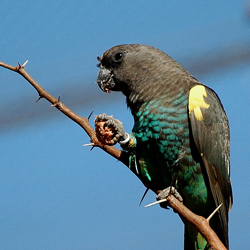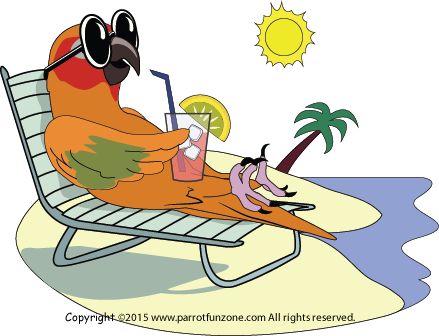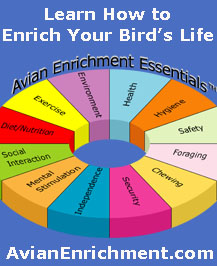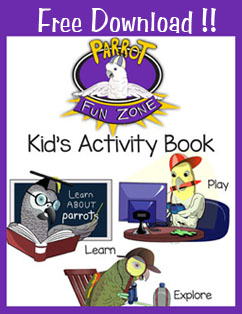Environment
|
Birds need stuff and lots of it! Birds in nature are surrounded by a very diverse environment filled with challenge, opportunity, risk and reward. They have endless choices when it comes to defining their territory, what they eat, choosing their mate and where they perch and sleep. We can't even come close to creating that kind of environment in our homes but we can strive to do our best to offer a wide variety of safe enrichments to our birds some of the key areas that need to be addressed are listed below: Cages The single most important item you will ever purchase for your parrot companion is its cage. Compared to the freedom they experience in the wild, our parrots are severely restricted in captivity. A cage is your bird's primary environment and it is of the utmost importance that they be able to move freely, flap their wings, climb, play, do acrobatics, forage and perch at multiple levels within that environment. The first rule when choosing a cage is to buy the largest possible cage that you can afford from both a space and financial perspective. Besides cage size, there are many factors that must be considered in making a safe and appropriate choice for your bird including:
These requirements can vary by bird species so it is best to take the time to research what would be the safest for your particular bird. Perches Your bird is on their feet 24/7. In the wild, they have a multitude of choices of where to perch and can fly from branch to branch giving their feet and legs exercise. In nature, parrots are also exposed to branches of various sizes, widths, and orientations. The perches in your bird’s cage should mimic these natural conditions as much as possible. By providing the proper variety of perches in your bird's cage you can help to prevent foot problems such as arthritis, tendonitis, atrophy or pressure sores from developing. Perches are available in a wide variety of natural and synthetic materials. A minimum of three different types of perches should be in your bird's cage. Since birds often like to sleep in the highest place that they can perch in their cage, it is recommended that the most comfortable perch be placed in this position. Play Areas Setting up outside of the cage play areas is a great way to offer your bird the opportunity to be in different areas of your home and to interact in a wider variety of manners with their human flock. There are many types of play areas including floor, table top and hanging varieties. No matter what the form, if properly designed and equipped, they offer the benefits of:
Well-designed play areas have:
Toys Toys are not just playthings to birds and they are not optional accessories. There are several different categories of toys and they can serve many different purposes. Toys are key to addressing our bird’s physical , instinctual and emotional needs. So what do toys mean to our birds? Toys can be:
Birds need to have a variety of toys across the various toy categories (destructible, foraging, preening, exercise) as well as variety within the categories. A minimum of 3-4 toys should be in your bird's cage and the toys should be rotated periodically as variety will help to alleviate boredom and keep your bird more curious and active. |
Related Articles
 Security
Security
 Play Time
Play Time







































































